Eco-Friendly Fireplace - What to Look for in a Green Option
By Editorial Team
Updated on January 24, 2025
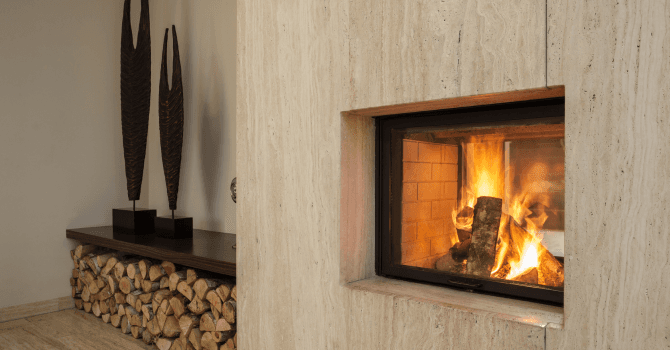
In many Canadian regions, fireplaces become the heart of the home for 3 out of the 4 seasons. The wood crackling in the hearth, the comforting smell of burning wood, and the cozy ambience of the room—whether we consciously acknowledge it or not—all contribute to a fireplace's undeniable charm.
While environmental problems have led government and municipal authorities to issue legislation regarding the use of fireplaces, as citizens, we may also have to question our choices. Fortunately for us, there are eco-friendly options that rival—both in terms of beauty and comfort—traditional wood-burning fireplaces.
Whether it’s electric, gas, propane gas, pellet, etc., the options aren’t lacking. Thus, when considering purchasing a more eco-friendly fireplace, it’s best to carefully weigh the various options available. After all, not everything can be taken at face value.
Let’s delve, full fire, into a red-hot topic.
Characteristics of an Eco-Friendly Fireplace for Inside Use
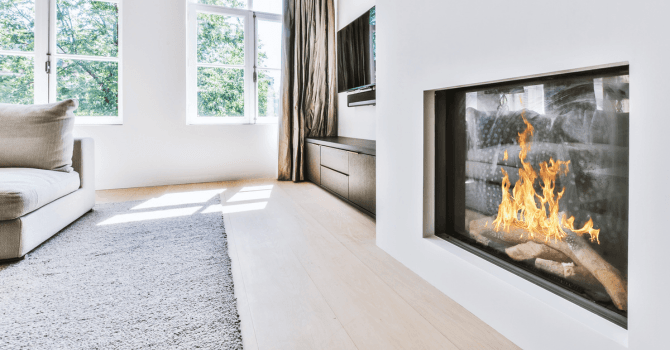
Source: Canva
An eco-friendly fireplace isn’t too harmful to the environment. It boasts clean combustion and increased energy efficiency, effectively heating a dwelling to desired temperatures. In a nutshell, it’ll meet your needs and wants, without having a negative impact on the environment.
Let’s put this out in the open right away: Finding a product that has zero environmental impact is especially challenging. Direct environmental damage results from a direct interaction between a product and the environment, for example, fireplace emissions. Indirect environmental damage isn’t a product-related hazard, although they may be linked. Therefore, when a fireplace is deemed eco-friendly, it, however, doesn’t exclude the fact that it can be the root cause of indirect environmental damage.
That said, one can significantly reduce their ecological footprint by making smart choices. Over the last few years, Natural Resources Canada, invested in research with the purpose of mitigating pollution and improving appliance energy efficiency. The result: Most fireplaces manufactured after 1990 are both more energy efficient and eco-friendly than their predecessors.
Eco-Friendly Benefits of Fireplaces
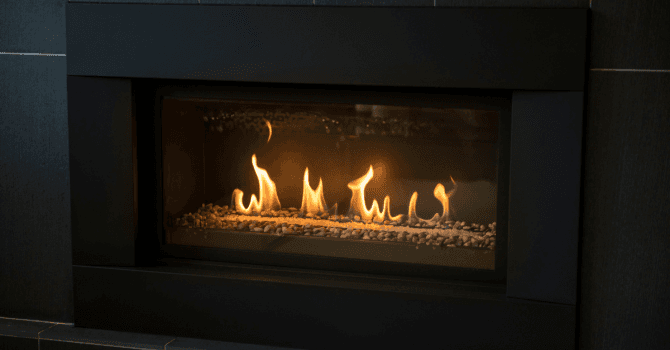
Source: Canva
While some fireplaces are considered more eco-friendly compared to others, note that even a wood-burning fireplace can show the planet some mercy. Here are the benefits associated with eco-friendly fireplaces.
Ethanol Fireplace
An ethanol fireplace is supplied by a biofuel known as ethanol, which is mainly derived from corn and sugarcane. The main advantage of this type of fireplace is that it can be easily inserted into the opening of an existing wood-burning fireplace.
Rather eco-friendly aside from the energy required to produce biofuel, it doesn’t emit any fumes. Its combustion is clean and practically odourless.
From an aesthetic point of view, the latter creates a cozy atmosphere while still giving off a stylish and modern look. Retailed at varied costs (from $700 to $6,000), it’s the best option for those looking to benefit from the cozy vibe but not necessarily a portable heater.
No Chimney: the Electric Fireplace
An electric heater is both ecological and safe and doesn’t consume fuel. It doesn’t emit any harmful particles, therefore, it doesn’t require a chimney installation or an exhaust duct. Basically, the flame-like visual is the product of the subtle use of light on mirror-like surfaces.
It runs without the need for an electrical outlet. You can set it up yourself, move it from one room to another at will, and use it in an apartment building in which wood-burning or gas fireplaces aren’t authorized. The energy produced doesn’t measure up to that of wood-burning or gas fireplaces but can suffice in terms of heating a 10 by 10 room. And, since it can run without emitting heat, one can benefit from its cozy setting 365 days a year!
Not only is it ecological, but this type of fireplace is economical; six hours of use barely costs a dollar. However, its main downside is that, without a generator, it can't double as a portable heater during a power outage.
Pellet Stove
A pellet stove is supplied by small pellets made from compressed sawdust, wood shavings, agricultural waste, and other organic materials. It’s very energy efficient, without so much as contributing to atmospheric pollution.
Once the tank is full, it can run for 12 to 24 hours, thereby converting up to 80% of the fuel into heat. A house that’s under 1,500 square feet can thus be heated with the use of a single boiler. For a bigger home, we recommend a larger biomass boiler that’s connected to the water heater or radiators.
Since pellet stoves cleanly burn renewable resources, it makes for an eco-friendly choice. In fact, the CO2 released into the atmosphere during the combustion process is equivalent to what’s absorbed by plants during their growth period, meaning the environmental balance is maintained.
Gas Fireplace
A gas fireplace can be supplied with artificial firelogs for the purpose of mimicking real firewood. While it does burn fossil fuels, it releases fewer harmful emissions and still generates comfortable heat. However, it’s the cleanest fuel one can burn. Its rate of greenhouse gas or particle emissions remains one of the lowest.
There are three options available, whether it’s gas or propane gas:
A gas fireplace insert, which is designed to fit directly into the opening of an existing wood-burning fireplace;
Zero-clearance gas fireplace, which can be installed on an indoor or outdoor wall;
Standalone fireplace, which looks exactly fire a wood-burning fireplace, meaning it can be admired on all sides and is the most energy-efficient option.
If the house in question is already fitted with a natural gas distribution system, the fireplace will be supplied using the same source as other appliances. Otherwise, the fireplace can be connected to a propane tank located outside, which will require occasional fillings.
PRO TIP: Prior to purchasing, request to see the flames, as not all models have realistic, nice-looking flames.
Wood-Burning Fireplace
While not long ago, the wood-burning fireplace was presented as the worst option, the industry has come a long way, making eco-friendly innovations over the last few years. So much so that, nowadays, people are reconsidering it.
New wood-burning fireplaces have an efficiency of over 70%, while their emissions are barely one-tenth of those emitted by traditional wood-burning fireplaces. Certain EPA-certified wood-burning stoves have a residue-free, clean combustion. Some maintain that the energy produced is neutral in terms of greenhouse gas emissions since the amount of fuel released while wood burns are equal to what’s released by a dead tree deteriorating in a forest.
Lastly, due to the current restrictions imposed on the forest industry, more trees must be planted than cut down. Wood is a renewable source of energy. By buying locally, you’re thereby reducing the carbon footprint associated with material transportation.
Ventless or Flueless Fireplaces
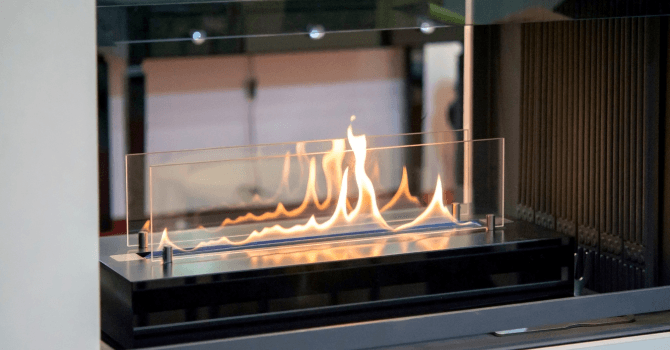
Source: Canva
A fireplace fire is always enjoyable; however, it may not necessarily be eco-friendly since, normally, a chimney is synonymous with emissions. Pollution and greenhouse gases produced during combustion can be harmful to the environment. As a result, one can conclude that ventless fireplaces have an eco-friendly advantage over those that require a chimney or vents, or at the very least, in terms of direct repercussions.
Here are 4 types of ventless fireplaces:
Propane or Natural Gas Fireplace
More and more homeowners are favouring this type of fireplace that can be installed practically everywhere since it doesn’t require a chimney. It only requires an exhaust duct or a vent used to exhaust the gas combustion outside.
Electric fireplace
The electric fireplace doesn’t require an exhaust system. It doesn’t burn fuel and doesn’t generate smoke.
Ethanol Fireplace
This type of fireplace generates clean combustion. Albeit it doesn’t need an exhaust duct, it still releases a subtle odour. Some experts suggest planning ahead for outward ventilation.
Gel Fuel Fireplace
Although it isn’t really sought-after, the gel fuel fireplace is slowly breaking ground in Quebec. It’s a worthwhile option for those who have a chimneyless home. While some models are rather decently sized and have a mantel (like the real deal!), smaller-sized models can be easily positioned atop furniture.
Its fuel is non-polluting—it’s a thickened isopropyl alcohol to which sea salt is added to obtain a pleasant fire-like crackling sound. While its gel-fueled logs are still hard to find in stores, it’s still a wise choice for those who live in an area where air quality restrictions are rather strict.
What is the top, most environmentally-friendly type of fireplace?
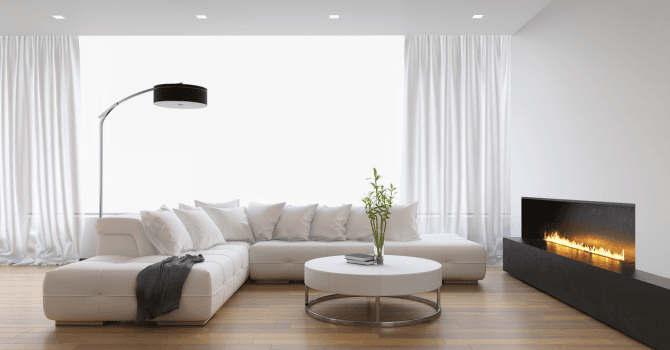
Source: Canva
When purchasing an eco-friendly fireplace, one has to consider the direct environmental impacts, as well as indirect impacts.
As the most eco-friendly solution is the least damaging to the environment as a whole, consider not only what the fireplace releases into the air, but also what it uses to run (where the fuel comes from, electricity supply) and what's required to manufacture the device. For example, an ethanol fireplace may seem like the best option because of its minimal direct impact, yet the pollution involved in its manufacturing process must also be taken into account.
Given all these factors, an electric fireplace stands out as the most environmentally-friendly choice on the market. It produces zero toxic fumes or greenhouse gas emissions. It requires no fuel, and 100% of its energy is converted into heat. Moreover, while it can't heat the whole house, it releases a significant amount of heat and can cut your heating costs by 20 to 40%.
In terms of the indirect environmental impact associated with an electric fireplace, hydroelectricity is the preferred ecological option in the province of Quebec. However, if you live in a province where electricity is coal-fired, such as Alberta, Saskatchewan, or in the Maritimes, you might want to rethink that option.
Cost of Eco-Friendly Outdoor Fireplace Logs
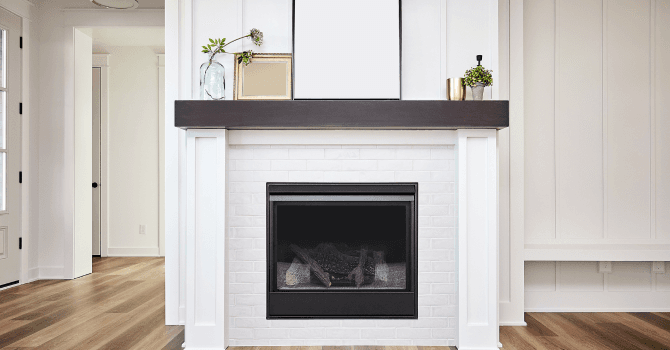
Source: Canva
While a lot of people benefit from outdoor fireplaces six months out of the year, true, hard-core fans never seem to take a break. Eco-friendly firewood is naturally a good alternative to real firewood logs. The former is 100% natural and made from hardwood sawdust and is devoid of chemical products and additives. They're high-density logs that burn longer, meaning you don't have to keep feeding the fire. Plus, they produce a pretty flame and release up to 30% more heat.
Since they’re retailed in most stores, you can buy as you go and don’t need to stock up and have a dedicated storage area. One can purchase a 6-log bag for $4.49 only. A pallet (72 bags or 576 logs) costs roughly $475.
Worth a try: The buchandel (a combination of the French words for log and candle) as it’s known in Quebec—literally taking an eco-friendly log and lighting its tip to create a candle-like effect. Its high-burning flame generates tremendous heat, and it's easy to light, smoke-free and burns for over an hour.
FAQ
Are wood fireplaces bad for the environment?
To put it bluntly, yes, it is bad for the environment. Wood heating is popular in parts of B.C., for example, but it generates more pollution than alternatives like electricity or natural gas. It releases various pollutants, including fine particulate matter (PM2.5), volatile organic compounds, carbon monoxide, and polycyclic aromatic hydrocarbons (PAH). Home wood heating accounts for around 27% of PM2.5 emissions in B.C., with even higher levels in some communities.
How can I make my wood fireplace more eco-friendly?
While there's no way to completely eliminate the pollution caused by burning wood, there are steps that can be taken to lessen its environmental impact. Options include upgrading to a newer fireplace to ensure to heat is being lost, making sure your home is well-insulated, and sourcing local wood to burn.
Are gas fireplaces bad for the environment?
Gas fireplaces are known for burning cleanly. In comparison to wood fireplaces, those powered by natural gas or propane emit significantly lower levels of carbon monoxide and particulate matter. Nonetheless, no energy source is entirely free of environmental impact.
What is the best, most eco-friendly fireplace fuel?
Bioethanol is a go-to when looking for a greener alternative. It's clean burning, renewable, and carbon neutral.
Get 3 quotes for your green renovation project
RenoQuotes.com can help you get quotes for your eco-friendly renovation project. If you submit your project, we’ll put you in contact with top-rated contractors. Fill in the form on the homepage (it only takes a few minutes) and get estimates from trusted professionals.
Dial 1-844 828-1588 to speak with one of our customer service representatives.
Looking for something else?
Related articles
The latest industry news, interviews, technologies, and resources.

Editorial Team
•07 Nov 2023
The floors of the foyer are easily the most beat up thanks to our harsh Canadian winters that have us tracking slush and mud inside. Since this is the room used to remove boots, shoes and other outerwear, it is important to make sure the life of your floors is extended as long as possible.

Editorial Team
•13 Aug 2024
Is water leaking into your house after heavy rainfall? Depending on the situation, it can become a major concern. How can you go about finding the source of the leak? How do you evaluate the severity of the leak? What measures can be taken to limit damages? Here are some key tips for knowing how to protect your home efficiently and prevent future setbacks.

Editorial Team
•05 Dec 2023
We’re still a few weeks (months) away from summer, but it’s never too early to start thinking about that warm weather and its effect on your home. During those particularly scorching months, air conditioning is a modern-day lifesaver. Even on the hottest of summer afternoons, it’ll cool you down and bring your energy levels back up.

Léa Plourde-Archer
•12 Jun 2025
When it comes to interior transformations and renovations, walls are one of the first elements that come to mind. They are often one of the least expensive renovations, and many people decide to complete the work themselves.

Léa Plourde-Archer
•13 Nov 2024
This article is aimed at both the client and the contractor who will be responsible for the renovation project. Both have a vested interest in making sure that the contract they sign is clear and contains all the information that is important to specify. For both parties, this is a question of protection and clarity.